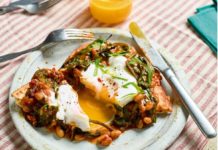Let’s be honest, how many of us actually bother to turn over the food and drinks we buy to read the nutritional information on the back? Or if you do, how easy is it really to read and understand food labels properly?
Most of the time, we’re in a rush to get in and out of the supermarket. Keen to load up our baskets and breeze through the checkout as quickly as possible. It doesn’t help either that nutritional information can be hard to understand, making it difficult to know if you’re making healthy choices or not.
If this sounds like a relatable scenario, you’re not alone. Figures suggest two-thirds of Brits are already overweight or obese, and food packaging could be partly to blame. We reveal the sneaky tactics brands and shops use to get us to buy into high-calorie or processed foods.
It’s never too late to start thinking about the quality of the foods you’re eating, or to learn the language of food labelling.
Not sure where to start?
How to read food labels properly
1. Be wary of of ‘sugar-free’ claims
A lot of people think they’re making healthy choices by picking up sugar-free alternatives to their favourite foods. But when you read their food labels, you’ll notice these can be packed with artificial additives that aren’t great for us either.
“If a food or drink is described as ‘low sugar’, ‘slimline’ or ‘diet’, it will usually contain an artificial sweetener,” says Dr Marilyn Glenville. She’s the author of Natural Alternatives to Sugar (available on Amazon).
“These sweeteners have been linked to mood swings and depression. It has been found that people who regularly use artificial sweeteners tend to gain weight. It can slow down the digestive process and increase appetite.”
2. Don’t rely on health claims on the front of the packaging
“Always read food labels before choosing what you buy,” says nutritionist Michela Vagnini from Natures Plus UK. “Unlike the nutrition labels, front-of-the-box packaging is not tightly regulated. It can promise guilt-free food and give us a false sense of health.”
A good example is the ‘zero fat’ myth. UK food regulations state that producers can claim that their food is ‘fat-free’ if it contains no more than 0.5g of fat per 100g or 100ml. But if you eat a 100g portion of a ‘fat-free’ food that contains 0.5g of fat every day for a week. That means you’ve unwittingly consumed an extra 3.5g of fat.
It might not sound like much, but it can add up over the months and years. Especially if you’re regularly loading your fridge with lots of these ‘fat-free’ products.
3. Ingredients are listed in weight order
One of the most important tricks of reading food labels is checking the ingredients list. It will tell you everything you need to know about how healthy each product is. Everything that goes into your food will be listed in weight order from biggest to the smallest, so the main ingredients in the packaged food always come first.
If the first few ingredients are high in saturated fat or sugars – like cream, butter, oil, syrups or fatty meat, it’s worth bearing in mind that these make up the biggest share of what you’re eating.
4. Gravitate towards green
If the nutrition labels use colour coding, you will often find a mixture of red, amber and green on the packaging. Paying attention to the colours alone can help you make healthier choices.
“The colours on the front of the pack show, at a glance, whether a product is high, medium or low in fat, saturates, sugars or salt,” says Hannah Pearse, head of Nutrition and Scientific Affairs at IGD.
“For a healthier choice, go for products with more greens and fewer reds. You don’t have to avoid all foods with a red colour on the nutrition label, but eating fewer reds and less often can help you achieve a healthier diet.
“A food could be high (red) in sugars but low (green) in fat, for example, so look out for the overall balance in your diet,” says Pearse. “If two products have the same colour coding on the nutrition label, look at the numbers to compare in more detail.”
5. Know your portion size
“Always check the pack for the portion size – this is what the numbers on the nutrition label are based on,” says Pearse.
“If you are eating more or less than the portion size shown, you need to adjust the numbers shown on the nutrition label.”
A common example is meal deal drinks. Most of these drinks actually claim to have 2 servings. If this is the case, make sure you double everything on the nutrition label.
6. Know your daily allowance
Food labels show you how many calories and how much fat, saturates, sugars and salt a portion of food or drink contains. It should appear both in grams and as a share of your daily allowance.
“Use the percentages on the nutrition label to track whether you’re under or over your daily allowance (known as a Reference Intake or RI),” says Pearse.
“The daily allowances (RI) are recommended by an independent panel of scientific experts and endorsed by the Department of Health.”
7. Know your calories
When deciding between two of the same product, have a quick check to see which has a higher number of calories per 100g or 100ml serving.
“The average woman needs 2,000 calories per day, the average man 2,500 and children fewer than 2,000 depending on their age,” says Pearse. “You’ll usually see two values on labels, kcal and kJ, but you should look out for kcal or calories.”
8. Sugars can be sneakily hidden under other names
Finally, If you’re worried about the amount of sugar you’re consuming (and we all should be), be wise to the fact it can often be disguised under different names.
Honey, syrup, molasses, nectar, fruit juice concentrate and generally anything ending in ‘ose’, such as glucose and maltose, are all names for added sugar.
Cereals, salad dressings, soups and sauces are some of the main culprits to look out for when it comes to misleading hidden ingredients.
You may also be interested in…
This article may include affiliate links to products and services where we may receive a small fee to support the running of this site if you make a purchase or is a sponsored article from one of our select editorial partners providing valuable advice and information to our readers.








































































